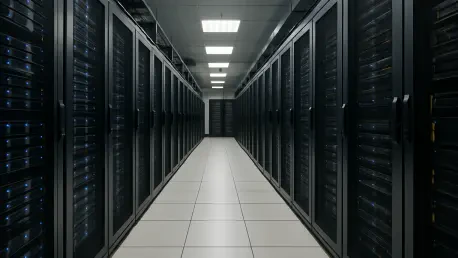As the digital age accelerates, California finds itself grappling with an unprecedented challenge: the explosive growth of data centers, often called server farms, that support everything from social media platforms to cutting-edge AI applications like ChatGPT. These facilities, while vital to the modern economy, are raising serious concerns due to their immense environmental and economic impact. With the state hosting one of the world’s largest clusters of such centers, lawmakers in 2024 embarked on a mission to curb their effects through a series of ambitious legislative proposals. The urgency stems from the sheer scale of resource consumption and the potential ripple effects on communities already strained by drought and rising utility costs. This tension between technological progress and sustainability has ignited a fierce debate, pitting innovation against the need to protect natural resources and consumer interests. What unfolded in the legislative arena offers a glimpse into the complexities of regulating an industry at the heart of the digital revolution.
Environmental Challenges of Data Centers
Resource Consumption Crisis
The environmental burden of data centers in California cannot be overstated, particularly when it comes to their enormous appetite for water and electricity. These facilities, especially those powering AI-driven operations, rely heavily on cooling systems to prevent overheating of high-performance semiconductors. This process consumes vast amounts of water and energy, placing significant stress on local resources. As of May 2024, around 17 planned data center projects were slated for regions already classified as having high or extremely high water stress. Such developments threaten to worsen existing challenges like reservoir depletion and prolonged drought, especially in a state where water scarcity is a constant concern. The sheer scale of this consumption raises critical questions about how long these areas can sustain such demands without severe ecological consequences, pushing regulators to seek urgent solutions.
Beyond the raw numbers, the environmental crisis tied to data centers also reflects a broader mismatch between their operational needs and California’s natural limitations. Southern California and the Bay Area, both hubs for tech infrastructure, are among the most vulnerable to water shortages. The overlap between data center expansion and these drought-prone zones creates a perfect storm of risk, where the thirst for digital innovation directly competes with the basic need for sustainable water supplies. Academic research, including studies from Stanford University, has flagged California as a prime area for future data center growth, alongside other arid regions like Phoenix. This projection only heightens the stakes, as unchecked development could tip already fragile ecosystems into crisis. Lawmakers are thus under pressure to devise policies that mitigate these impacts before they spiral further out of control.
Climate and Energy Intersections
Another dimension of the environmental challenge lies in the energy demands of data centers and their contribution to greenhouse gas emissions. These facilities often require constant power to maintain servers, with many still reliant on fossil fuel-based grids despite pushes for renewable energy. In a state committed to ambitious climate goals, this dependency poses a direct conflict with efforts to reduce carbon footprints. The strain on California’s energy infrastructure is evident, as the need for new power plants and transmission lines grows alongside data center proliferation. Without targeted regulation, this could undermine broader sustainability targets, making it harder to transition to cleaner energy sources while meeting digital economy demands.
Moreover, the intersection of energy use and climate impact reveals a troubling lack of oversight on how data centers align with environmental priorities. Industry advocates often argue that technological advancements will eventually reduce energy needs, yet current trends show little evidence of such efficiencies materializing at scale. Community concerns are mounting over whether the state can balance its role as a tech leader with its environmental commitments. The absence of mandatory energy disclosure from operators further clouds the picture, leaving policymakers with incomplete data to address these pressing issues. As California navigates this complex terrain, the need for robust, forward-thinking legislation becomes increasingly apparent to safeguard both the planet and the digital future.
Economic Impacts on Communities
Cost-Shifting Concerns
Turning to the economic ramifications, a primary worry for California residents is the potential for cost-shifting tied to data center expansion. The infrastructure required to support these facilities—new power plants, transmission lines, and grid upgrades—comes with a hefty price tag. Many fear that these expenses could be passed on to everyday consumers, resulting in higher electricity bills for households and small businesses already struggling with tight budgets. This concern was a driving force behind legislative proposals like Senate Bill 57 (SB 57), which initially sought to ensure that data center operators bear the financial burden of their growth. However, the dilution of such measures during the 2024 legislative process has left many skeptical about whether ratepayers will be adequately protected from these looming costs.
The economic unease extends beyond just utility bills, touching on broader questions of fairness and equity in how infrastructure costs are distributed. Small businesses, often lacking the resources to absorb sudden rate hikes, could face disproportionate impacts compared to the tech giants operating data centers. Consumer advocacy groups, such as The Utility Reform Network (TURN), have voiced frustration over the weakened state of protective legislation, arguing that the influence of industry lobbyists has prioritized corporate interests over public welfare. Without stronger safeguards, there’s a risk that communities least equipped to handle additional financial strain will bear the brunt of supporting an industry that fuels global digital progress. This imbalance continues to fuel debate over how to equitably manage the economic fallout of data center growth.
Long-Term Financial Risks
Looking further ahead, the long-term financial risks of unchecked data center expansion pose a significant challenge for California’s economy. If infrastructure costs continue to mount without clear mechanisms to allocate them fairly, public trust in both utilities and regulators could erode. This scenario might also deter smaller enterprises from thriving in a state where operating costs are already high, potentially stifling local economic diversity. The ripple effects could extend to housing affordability and quality of life, as rising utility expenses compound existing pressures on residents. Policymakers are thus tasked with anticipating these downstream impacts while crafting regulations that prevent a future where tech growth comes at the expense of community stability.
Additionally, the lack of transparency around data center energy demands complicates efforts to predict and mitigate these financial risks. Without clear data on how much power these facilities consume or plan to use, utilities and regulators struggle to plan for sustainable grid expansions. This uncertainty could lead to overbuilding infrastructure, further inflating costs that might ultimately fall on ratepayers. Industry resistance to sharing such information, often citing competitive concerns, only deepens the problem, leaving gaps in the state’s ability to forecast economic impacts. Addressing these long-term risks requires not just legislative action but a commitment to data-driven planning that balances tech advancement with the fiscal health of California’s diverse communities.
Legislative Efforts and Outcomes
Transparency and Accountability Battles
Transparency remains a central battleground in California’s push to regulate data centers, with significant friction over how much information operators should disclose. Assembly Bill 93 (AB 93), one of the surviving pieces of legislation from 2024, mandates that data centers report estimated water usage to their suppliers as part of licensing processes. However, a critical amendment redirected this data away from public entities to private suppliers, drawing sharp criticism from activists who argue that this limits community access and hampers grassroots efforts to hold operators accountable. Without public disclosure, it becomes challenging for local stakeholders to fully understand and address the environmental toll of these facilities, leaving a gap between policy intent and practical impact.
The struggle for accountability also faces stiff resistance from industry players, particularly Big Tech firms and groups like the Silicon Valley Leadership Group. Their argument hinges on the protection of trade secrets, claiming that revealing detailed water and energy usage could undermine competitive advantages. This stance has significantly weakened transparency provisions across multiple bills, frustrating lawmakers and environmental advocates who see such data as essential for informed policymaking. The resulting legislative compromises reflect a broader tension between fostering innovation and ensuring public oversight, with critics contending that the scales have tipped too far toward corporate interests. As this debate persists, the question of how to enforce meaningful accountability without stifling growth remains unresolved.
Diluted Legislation
Examining the specific outcomes of 2024’s legislative efforts, Senate Bill 57 (SB 57) stands out as a stark example of ambition curtailed by compromise. Initially crafted by Senator Steve Padilla, the bill aimed to mirror protections in states like Oregon by preventing data center infrastructure costs from being shifted to residential ratepayers. Yet, amendments in the Assembly Appropriations Committee stripped away key provisions, such as a special payment structure for operators, reducing the bill to a symbolic authorization for the California Public Utilities Commission (CPUC) to assess impacts—an authority it already held. Supporters like TURN expressed deep disappointment, pointing to industry lobbying as the culprit behind this gutting of consumer protections, though they still urged Governor Newsom to sign the bill as a minimal step forward.
Similarly, Assembly Bill 93 (AB 93), introduced by Assemblymember Diane Papan, emerged from the legislative gauntlet with diminished scope. Focused on water consumption, the bill requires operators to report usage data but limits this disclosure to water suppliers rather than government or public bodies. Critics, including community activists, argue that this restriction undermines true transparency, as accessing such data becomes a bureaucratic hurdle. Researchers have noted historical challenges in obtaining water records, further casting doubt on the bill’s effectiveness. Despite these shortcomings, some proponents view AB 93 as a foundation for future efficiency standards, hoping it empowers local agencies to scrutinize data center projects more rigorously. Both bills, though weakened, highlight the uphill battle of enacting robust regulation in the face of powerful opposition.
Broader Context and Future Outlook
National and Regional Parallels
California’s regulatory struggles with data centers are not an isolated phenomenon but part of a national and regional pattern as these facilities proliferate across the United States. States like Michigan, Arizona, Georgia, and Virginia are confronting similar dilemmas, where the promise of economic growth through tech infrastructure clashes with environmental and cost concerns. In water-scarce areas like Arizona, local opposition mirrors California’s over fears of resource depletion, while Virginia grapples with grid strain from data center clusters. This shared challenge points to a growing recognition among policymakers that oversight is necessary, though the diversity of approaches—from outright bans on certain projects to incentive-based models—underscores the lack of a unified strategy. California’s experience thus serves as a critical case study within this wider landscape.
The parallels across states also reveal an opportunity for cross-regional learning, as varied experiments in regulation unfold. While California’s 2024 legislative outcomes were mixed, with only two diluted bills reaching the governor’s desk, they offer insights for other jurisdictions. For instance, states with less tech industry clout might push for stricter transparency rules unencumbered by the lobbying seen in Sacramento. Conversely, California could draw inspiration from innovative cost-sharing models in places like Oregon. This national dialogue suggests that while no single solution fits all, a collaborative framework—potentially involving federal guidelines—could emerge to address common issues like water stress and energy demand. The evolving conversation underscores the need for adaptive policies that respond to both local conditions and broader trends in digital infrastructure growth.
Pathways to Sustainable Regulation
Reflecting on the efforts of 2024, it’s evident that California’s attempt to regulate data centers stumbled under the weight of industry pushback, leaving behind two bills that fell short of their original goals. Senate Bill 57 and Assembly Bill 93, though steps in the right direction, lacked the enforceability to tackle the scale of resource and cost challenges head-on. Their passage, if signed into law by Governor Newsom, marked a moment of incremental progress rather than transformative change, highlighting the difficulty of balancing a tech-driven economy with public and environmental needs. The influence of Big Tech lobbying was a recurring barrier, often overshadowing the voices of community advocates and environmentalists who sought stronger accountability.
Looking ahead, actionable pathways emerged from the lessons of those legislative battles. Strengthening transparency by mandating public disclosure of water and energy data could rebuild trust and empower communities to engage in oversight. Additionally, revisiting cost-protection mechanisms with enforceable mandates, rather than mere authorizations, would better shield ratepayers from financial burdens. Collaboration with other states to develop shared standards might also amplify California’s influence, creating a blueprint for sustainable data center growth. As digital demands continue to surge, prioritizing research into AI’s environmental impact and incentivizing renewable energy adoption will be crucial. These steps, if pursued with resolve, could position California as a leader in harmonizing technology with sustainability for the future.









